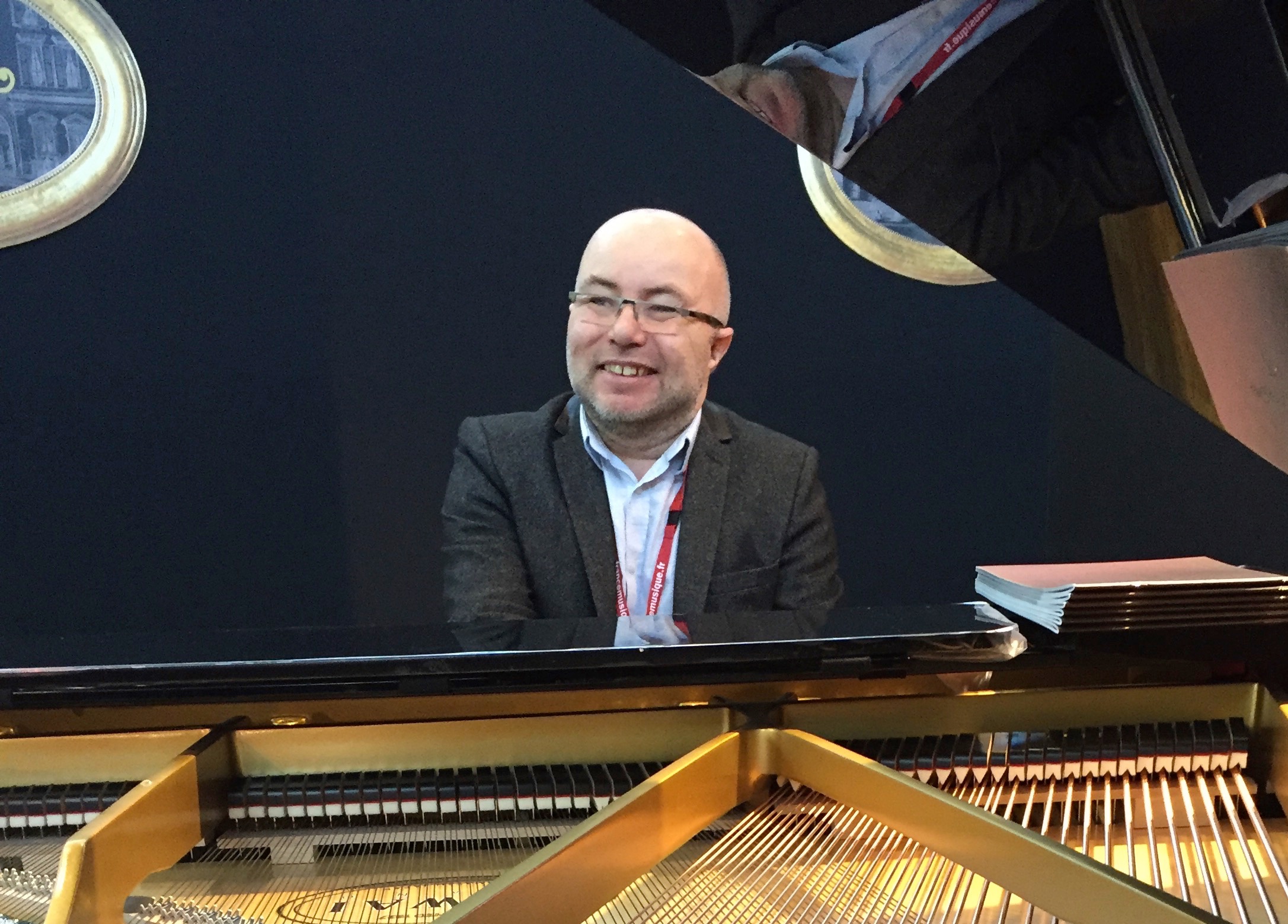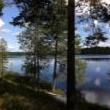-
Posts
1,059 -
Joined
-
Last visited
Reputation Activity
-
 Stephane Boussuge got a reaction from AM in How to get time signature to repeat for each list in dictum?
Stephane Boussuge got a reaction from AM in How to get time signature to repeat for each list in dictum?
In that case, you can use substitute-map. Here's a short example for woodwind trio:
;;;--------------------------------------------------------- ;;; Parameters (setf material '(#|1|# (q. f4 f e fs4 q d4 s c4 f4 a4 fs4) #|2|# (e d4 f c4 f4 a4 fs4 b4 eb4 f4) #|3|# (h f4 a4) #|4|# (h fs4 f b4) #|5|# (h eb4 f4) #|6|# (q. gs4 mp e c4 q f4 s a4 a4 gs4 b4) #|7|# (h f4 mp a4) #|8|# (q. a4 mp e gs4 q b4 s gs4 c4 b4 fs4) )) (setf fl.index '(1 2 1 3 1 4 5 6 7 8)) (setf ob.index '(3 2 4 3 5 4 6 5 7 6)) (setf bn.index '(1 2 2 1 1 3 3 1 1 4)) (setf ref-list (gen-integer 1 (length material))) (setf flute (substitute-map material ref-list fl.index)) (setf oboe (substitute-map material ref-list ob.index)) (setf bassoon (pitch-transpose -24 (substitute-map material ref-list bn.index))) ;;;--------------------------------------------------------- ;;; Score and Layout (def-score woodwind-trio (:title "Title" :composer "Composer" :copyright "Copyright © " :key-signature 'chromatic :time-signature '((1 1 1 1) 4) :tempo 100 :layout (wind-trio-layout 'flute 'oboe 'bassoon)) (flute :omn flute :channel 1 :sound 'gm :program 'flute :volume 95 :pan 70 :controllers (91 '(52)) ) (oboe :omn oboe :channel 2 :sound 'gm :program 'oboe :volume 95 :pan 54 :controllers (91 '(55)) ) (bassoon :omn bassoon :channel 3 :sound 'gm :program 'bassoon :volume 95 :pan 70 :controllers (91 '(57)) ) ) SB.
-
 Stephane Boussuge got a reaction from o_e in How to get time signature to repeat for each list in dictum?
Stephane Boussuge got a reaction from o_e in How to get time signature to repeat for each list in dictum?
In that case, you can use substitute-map. Here's a short example for woodwind trio:
;;;--------------------------------------------------------- ;;; Parameters (setf material '(#|1|# (q. f4 f e fs4 q d4 s c4 f4 a4 fs4) #|2|# (e d4 f c4 f4 a4 fs4 b4 eb4 f4) #|3|# (h f4 a4) #|4|# (h fs4 f b4) #|5|# (h eb4 f4) #|6|# (q. gs4 mp e c4 q f4 s a4 a4 gs4 b4) #|7|# (h f4 mp a4) #|8|# (q. a4 mp e gs4 q b4 s gs4 c4 b4 fs4) )) (setf fl.index '(1 2 1 3 1 4 5 6 7 8)) (setf ob.index '(3 2 4 3 5 4 6 5 7 6)) (setf bn.index '(1 2 2 1 1 3 3 1 1 4)) (setf ref-list (gen-integer 1 (length material))) (setf flute (substitute-map material ref-list fl.index)) (setf oboe (substitute-map material ref-list ob.index)) (setf bassoon (pitch-transpose -24 (substitute-map material ref-list bn.index))) ;;;--------------------------------------------------------- ;;; Score and Layout (def-score woodwind-trio (:title "Title" :composer "Composer" :copyright "Copyright © " :key-signature 'chromatic :time-signature '((1 1 1 1) 4) :tempo 100 :layout (wind-trio-layout 'flute 'oboe 'bassoon)) (flute :omn flute :channel 1 :sound 'gm :program 'flute :volume 95 :pan 70 :controllers (91 '(52)) ) (oboe :omn oboe :channel 2 :sound 'gm :program 'oboe :volume 95 :pan 54 :controllers (91 '(55)) ) (bassoon :omn bassoon :channel 3 :sound 'gm :program 'bassoon :volume 95 :pan 70 :controllers (91 '(57)) ) ) SB.
-
 Stephane Boussuge got a reaction from Cliff in How to get time signature to repeat for each list in dictum?
Stephane Boussuge got a reaction from Cliff in How to get time signature to repeat for each list in dictum?
In that case, you can use substitute-map. Here's a short example for woodwind trio:
;;;--------------------------------------------------------- ;;; Parameters (setf material '(#|1|# (q. f4 f e fs4 q d4 s c4 f4 a4 fs4) #|2|# (e d4 f c4 f4 a4 fs4 b4 eb4 f4) #|3|# (h f4 a4) #|4|# (h fs4 f b4) #|5|# (h eb4 f4) #|6|# (q. gs4 mp e c4 q f4 s a4 a4 gs4 b4) #|7|# (h f4 mp a4) #|8|# (q. a4 mp e gs4 q b4 s gs4 c4 b4 fs4) )) (setf fl.index '(1 2 1 3 1 4 5 6 7 8)) (setf ob.index '(3 2 4 3 5 4 6 5 7 6)) (setf bn.index '(1 2 2 1 1 3 3 1 1 4)) (setf ref-list (gen-integer 1 (length material))) (setf flute (substitute-map material ref-list fl.index)) (setf oboe (substitute-map material ref-list ob.index)) (setf bassoon (pitch-transpose -24 (substitute-map material ref-list bn.index))) ;;;--------------------------------------------------------- ;;; Score and Layout (def-score woodwind-trio (:title "Title" :composer "Composer" :copyright "Copyright © " :key-signature 'chromatic :time-signature '((1 1 1 1) 4) :tempo 100 :layout (wind-trio-layout 'flute 'oboe 'bassoon)) (flute :omn flute :channel 1 :sound 'gm :program 'flute :volume 95 :pan 70 :controllers (91 '(52)) ) (oboe :omn oboe :channel 2 :sound 'gm :program 'oboe :volume 95 :pan 54 :controllers (91 '(55)) ) (bassoon :omn bassoon :channel 3 :sound 'gm :program 'bassoon :volume 95 :pan 70 :controllers (91 '(57)) ) ) SB.
-
 Stephane Boussuge got a reaction from JimmyTheSaint in How to get time signature to repeat for each list in dictum?
Stephane Boussuge got a reaction from JimmyTheSaint in How to get time signature to repeat for each list in dictum?
Hi,
here's your code slightly modified to give you and example of the usage of counterpoint function with multiple lists.
As you can see, the :sequence keyword in dictum allow you to choose for each instrument in which list you pick the patterns.
I've added 2 more lines to your dictum to show how to use :span to constrain the time signature on some bars.
The :extend keyword allow you to add rest at the end (default) or at the start (:extend '(s))) of the bar when a bar is extended by :span keyword.
Hope this example will help.
Best regards.
Stéphane Boussuge
(progn (setf my-dictum '(((- 1 2 -) :sequence '(1 1 2 1)) ((1 - - 2) :sequence '(1 1 2 1)) ((2 - - 2) :sequence '(1 1 2 1)) ((1 2 2 1) :sequence '(1 1 2 1)) ((3 1 3 2) :span 4/4 :sequence '(1 1 2 1) :extend '(- s s -)) ((4 1 4 1) :span 2/4 :sequence '(1 1 2 1)) )) (setf times (* 1 (length my-dictum))) (setf my-root -0) (setf my-intervals '(0 1 4 7)) (setf my-pitches (pitch-transpose my-root (integer-to-pitch my-intervals))) (setf my-lengths (rnd-sample times '((q e) (q q)) :seed 356)) (setf my-articulations (span my-lengths '(-))) (setf my-velocities '(pp p mp mf f ff)) (setf my-sequence (make-omn :length my-lengths :pitch my-pitches :velocity my-velocities)) (setf my-chord-sequence (make-omn :length my-lengths :pitch (gen-chord2 '(2 4) '(2 2 3 4) '((c4 cs4 e4 g4) (c4 cs4 e4 g4))) :velocity my-velocities :articulation my-articulations)) (setf my-time-signature (get-time-signature my-sequence)) (counterpoint (list my-sequence my-chord-sequence) my-dictum :global-methods '((fl) (cl) (hn) (vc)) :index 'voice1-) (ps 'gm :fl (list voice1-1) :cl (list voice1-2) :hn (list voice1-3) :vc (list voice1-4) :tempo 161 ) )
-
 Stephane Boussuge got a reaction from Nikos in Etude pour Orchestre du 4.5.2023
Stephane Boussuge got a reaction from Nikos in Etude pour Orchestre du 4.5.2023
I’m always amazed by the incredible power of Opusmodus and the inspiration it give to me to compose and explore new possibilities .
Actually, I'm playing and experimenting a bit with OM and orchestra,
preparing my next package of video lessons for ComposerWorkshop.com.
Today, I've made this output from my experiences, nothing extraordinary but I wanted to share it as an example of what we can make with Opusmodus in about 1h.
It's basically only Slonimsky patterns distributed to the orchestra on an heterophonic way with transpositions from Opusmodus bind-to-interval function (set to "0")
Stéphane
Etude pour Orchestre 040523.wav
-
 Stephane Boussuge got a reaction from AM in Etude pour Orchestre du 4.5.2023
Stephane Boussuge got a reaction from AM in Etude pour Orchestre du 4.5.2023
I’m always amazed by the incredible power of Opusmodus and the inspiration it give to me to compose and explore new possibilities .
Actually, I'm playing and experimenting a bit with OM and orchestra,
preparing my next package of video lessons for ComposerWorkshop.com.
Today, I've made this output from my experiences, nothing extraordinary but I wanted to share it as an example of what we can make with Opusmodus in about 1h.
It's basically only Slonimsky patterns distributed to the orchestra on an heterophonic way with transpositions from Opusmodus bind-to-interval function (set to "0")
Stéphane
Etude pour Orchestre 040523.wav
-
 Stephane Boussuge got a reaction from erka in Etude pour Orchestre du 4.5.2023
Stephane Boussuge got a reaction from erka in Etude pour Orchestre du 4.5.2023
I’m always amazed by the incredible power of Opusmodus and the inspiration it give to me to compose and explore new possibilities .
Actually, I'm playing and experimenting a bit with OM and orchestra,
preparing my next package of video lessons for ComposerWorkshop.com.
Today, I've made this output from my experiences, nothing extraordinary but I wanted to share it as an example of what we can make with Opusmodus in about 1h.
It's basically only Slonimsky patterns distributed to the orchestra on an heterophonic way with transpositions from Opusmodus bind-to-interval function (set to "0")
Stéphane
Etude pour Orchestre 040523.wav
-
 Stephane Boussuge got a reaction from opmo in Etude pour Orchestre du 4.5.2023
Stephane Boussuge got a reaction from opmo in Etude pour Orchestre du 4.5.2023
I’m always amazed by the incredible power of Opusmodus and the inspiration it give to me to compose and explore new possibilities .
Actually, I'm playing and experimenting a bit with OM and orchestra,
preparing my next package of video lessons for ComposerWorkshop.com.
Today, I've made this output from my experiences, nothing extraordinary but I wanted to share it as an example of what we can make with Opusmodus in about 1h.
It's basically only Slonimsky patterns distributed to the orchestra on an heterophonic way with transpositions from Opusmodus bind-to-interval function (set to "0")
Stéphane
Etude pour Orchestre 040523.wav
-
 Stephane Boussuge got a reaction from edesert in Why I love OM - Part 1 - Orchestral sections generation
Stephane Boussuge got a reaction from edesert in Why I love OM - Part 1 - Orchestral sections generation
I truly love Opusmodus. In this new series of videos, I'm trying to show why.
This (basic) example show how Opusmodus could be used to generate and experiment with orchestral sections.
-
 Stephane Boussuge got a reaction from JimmyTheSaint in Why I love OM - Part 1 - Orchestral sections generation
Stephane Boussuge got a reaction from JimmyTheSaint in Why I love OM - Part 1 - Orchestral sections generation
I truly love Opusmodus. In this new series of videos, I'm trying to show why.
This (basic) example show how Opusmodus could be used to generate and experiment with orchestral sections.
-
 Stephane Boussuge got a reaction from Nikos in Why I love OM - Part 1 - Orchestral sections generation
Stephane Boussuge got a reaction from Nikos in Why I love OM - Part 1 - Orchestral sections generation
I truly love Opusmodus. In this new series of videos, I'm trying to show why.
This (basic) example show how Opusmodus could be used to generate and experiment with orchestral sections.
-
 Stephane Boussuge got a reaction from JimmyTheSaint in Where is code for lengths like "3h" for tuplets documented?
Stephane Boussuge got a reaction from JimmyTheSaint in Where is code for lengths like "3h" for tuplets documented?
It is in Document: 1.OMN The Language.
You can also get it here:
-
 Stephane Boussuge reacted to Wim Dijkgraaf in Converting MIDI or MusicXML to OMN
Stephane Boussuge reacted to Wim Dijkgraaf in Converting MIDI or MusicXML to OMN
Is anyone working on this? Is it planned in the product roadmap? If not, I would be able to give it a try. But that will be .NET based tool to convert MusicXML to OMN.
Would like to know if it's worth the effort (of value to the community, will not be a feature of OpusModus soon, ...) .
-
 Stephane Boussuge got a reaction from erka in Pluton for Orchestra
Stephane Boussuge got a reaction from erka in Pluton for Orchestra
In memoriam Narcis Bonet who was one of my teachers.
Opusmodus score attached.
SB.
PlutonV1-02.opmo
-
 Stephane Boussuge got a reaction from JimmyTheSaint in Pluton for Orchestra
Stephane Boussuge got a reaction from JimmyTheSaint in Pluton for Orchestra
In memoriam Narcis Bonet who was one of my teachers.
Opusmodus score attached.
SB.
PlutonV1-02.opmo
-
 Stephane Boussuge reacted to opmo in sysex to re-tune MTS synth for full microtonality
Stephane Boussuge reacted to opmo in sysex to re-tune MTS synth for full microtonality
Example with cents attributes:
'(e c4 1c - 12c - 23c - 34c - 45c - 56c - 67c - 78c)
-
 Stephane Boussuge got a reaction from paul in Méditation for String quartet
Stephane Boussuge got a reaction from paul in Méditation for String quartet
Hi,
here's a short score composed for string quartet.
All the best to all OM users !
Stéphane
stephaneboussuge · Méditation
MeditationPourRené.opmo
01 - Conducteur - Méditation.pdf
-
 Stephane Boussuge reacted to JulioHerrlein in Opsumodus for Windows Tutorial
Stephane Boussuge reacted to JulioHerrlein in Opsumodus for Windows Tutorial
Opusmodus 3.0 for Windows ( Basic Install and Workflow Setup )
In this video there is a tutorial for the installation and setup of Opusmodus 3.0 for Windows computers.
It also shows the Loop Midi Setup and integration with Reaper, Musescore and Libre Office.
LINKS
OPUSMODUS 3.0 - Windows
https://opusmodus.com/forums/downloads/
LOOP MIDI - Virtual Midi ports - Tobias Erichsen
https://www.tobias-erichsen.de/software/loopmidi.html
REAPER
https://www.reaper.fm/
MUSESCORE
https://musescore.org
LIBRE OFFICE
https://www.libreoffice.org/
CHAPTERS
00:00 - Intro
00:59 - Install Opusmodus
02:41 - First Look at Opusmodus Standalone
04:25 - Midi Setup
05:23 - Loop Midi Install
05:53 - Virtual Ports Setup
06:30 - Selecting Midi Inputs and Midi Entry
07:00 - DAW Midi Loop Setup (Reaper)
09:19 - Def-Instrument-set creation and setup midi
11:42 - Preview Score with def-instrument-set using VST and Reaper
12:20 - OMN for creating musical ideas
12:44 - Using the Preview Score with VST sounds in Reaper
14:36 - Opusmodus and Notation Software - Musescore
15:21 - Opusmodus and word processor software - Libre Office
-
 Stephane Boussuge reacted to Deb76 in OPUSMODUS 3 WINDOWS - MIDI SETUP ABLETON
Stephane Boussuge reacted to Deb76 in OPUSMODUS 3 WINDOWS - MIDI SETUP ABLETON
Hello RevJames,
I use Ableton Live 11 suite with OPMO to send the different midi parts into Live. It works very well and allows you to use all of Live's tools, native synthesizers, third-party virtuals, hardware synths, etc.
LoopMidi works great for creating the virtual ports needed in Windows to play midi parts on a Daw/Stan. Once open, just click + to add a port.
In Ableton Live or other Daw, check in Preferences if the ports are active. Then, just assign them in the instruments/midi track.
Be careful, do not forget in Opusmodus to check their assignments with (midi-destinations)_CTRL E.
I made a small PDF to summarize this topic. And since you work with Ableton Live, I'm interested in sharing.
LoopPortsOpmo.pdf
-
 Stephane Boussuge reacted to RST in Zoom into OM - 6. Pierrot ensemble section on the SACHER hexachord.
Stephane Boussuge reacted to RST in Zoom into OM - 6. Pierrot ensemble section on the SACHER hexachord.
This is wonderful - so clearly presented and deeply engaging of Opusmodus! I will return to this, in the meantime, BRAVO!
-
 Stephane Boussuge reacted to opmo in Opusmodus 3.0 Windows
Stephane Boussuge reacted to opmo in Opusmodus 3.0 Windows
OM v.3.0 Windows ready for download:
https://opusmodus.com/forums/downloads
LoopMIDI is a third-party application that allows you to create virtual MIDI ports on your Windows system:
loopMIDI | Tobias Erichsen
WWW.TOBIAS-ERICHSEN.DE
-
 Stephane Boussuge reacted to Wim Dijkgraaf in Converting MIDI or MusicXML to OMN
Stephane Boussuge reacted to Wim Dijkgraaf in Converting MIDI or MusicXML to OMN
Hello all,
Any progress on converting MusicXML to OMN?
-
 Stephane Boussuge got a reaction from Nikos in Zoom into OM - 6. Pierrot ensemble section on the SACHER hexachord.
Stephane Boussuge got a reaction from Nikos in Zoom into OM - 6. Pierrot ensemble section on the SACHER hexachord.
Hi folks,
new zoom into om:
SB.
-
 Stephane Boussuge got a reaction from lviklund in Zoom into OM - 6. Pierrot ensemble section on the SACHER hexachord.
Stephane Boussuge got a reaction from lviklund in Zoom into OM - 6. Pierrot ensemble section on the SACHER hexachord.
Hi folks,
new zoom into om:
SB.
-
 Stephane Boussuge got a reaction from AM in Etude pour ensemble
Stephane Boussuge got a reaction from AM in Etude pour ensemble
Short study made with the code showed in Zoom into OM No.6.
Audio output: Musescore 4.
Etude pour Ensemble V.02 by stephaneboussuge






